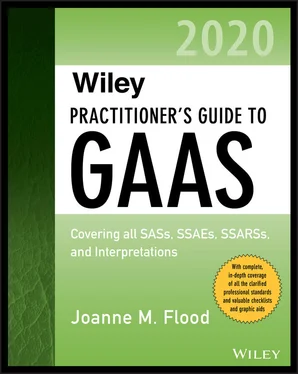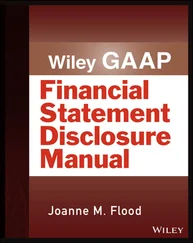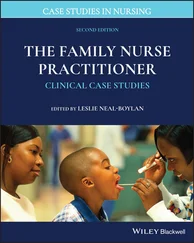The extent of procedures applied should reflect the assessment of fraud risk and may need to be adjusted. For example, the auditor may increase sample sizes, perform more detailed analytical procedures, or utilize more computer-assisted audit techniques.
(AU-C 240.30)
Appendix Bof AU-C 240 contains the following examples of ways to modify the nature, timing, and extent of tests in response to identified risks of material misstatement due to fraud:
Perform unannounced or surprise procedures at locations.
Ask that inventories be counted as closely as possible to the end of the reporting period.
Orally confirm with major customers and suppliers in addition to sending written confirmations.
Send confirm requests to a specific party in an organization.
Perform substantive analytical procedures using disaggregated data, such as comparing gross profit or operating margins by location, line of business, or month to auditor-developed expectations.
Interview personnel involved in areas where a fraud risk has been identified to get their views about the risk and how controls address the risk.
Discuss with other independent auditors auditing other subsidiaries, divisions, or branches the extent of work that should be performed to address the risk of fraud resulting from transactions and activities among those components.
If the work of an expert becomes particularly significant with respect to a financial statement item for which the assessed risk of misstatement due to fraud is high, perform additional procedures relating to some or all of the expert’s assumptions, methods, or findings to determine that the findings are not unreasonable, or engage another expert for that purpose.
Perform audit procedures to analyze selected opening balance sheet accounts of previously audited financial statements to assess how certain issues involving accounting estimates and judgments (for example, an allowance for sales returns) were resolved with the benefit of hindsight.
Examples of Responses to Identified Risks of Misstatements from Fraudulent Financial Reporting
The following examples are from AU-C 240 Appendix B:
Revenue recognition.The auditor may consider:
Performing substantive analytical procedures relating to revenue using disaggregated data, such as comparing revenue reported by month or by product line or business segment during the current reporting period with comparable prior periods.
Confirming with customers certain relevant contract terms and the absence of side agreements, because the appropriate accounting often is influenced by such terms or agreements (for example, acceptance criteria, delivery and payment terms, the absence of future or continuing vendor obligations, the right to return the product, guaranteed resale amounts, and cancellation or refund provisions often are relevant in such circumstances).
Inquiring of the entity’s sales and marketing personnel or in-house legal counsel regarding sales or shipments near the end of the period and their knowledge of any unusual terms or conditions associated with these transactions.
Being physically present at one or more locations at period-end to observe goods being shipped or being readied for shipment (or returns processing) and performing other appropriate cutoff procedures.
For those situations for which revenue transactions are electronically initiated, processed, and recorded, testing controls to determine whether they provide assurance that recorded revenue transactions occurred and are properly recorded.
Inventory quantities.The auditor may consider:
Examining the entity’s inventory records to identify locations or items that require specific attention during or after the physical inventory count.
Performing additional procedures during the count, such as rigorously examining the contents of boxes, checking for hollow squares in the manner in which goods are stacked, or examining the quality of liquid substances for purity, grade, or concentration.
Performing additional testing of count sheets, tags, or other records to reduce the possibility of subsequent alteration or inappropriate compilation.
Performing additional procedures to test the reasonableness of quantities counted, such as comparing quantities for the current period with prior periods by class or category of inventory or location.
Using CAATs.
Management estimates.The auditor may want to supplement the audit evidence obtained. The auditor may:
Engage a specialist to develop an independent estimate for comparison.
Extend inquiries to individuals outside of management and the accounting department to corroborate management’s ability and intent to carry out plans that are relevant to developing the estimate.
Examples of Responses to Identified Risks of Misstatements Arising from Misappropriation of Assets
The auditor will usually direct a response to identified risks of misstatements arising from misappropriation of assets to certain account balances. The scope of the work should be linked to the specific information about the identified misappropriation risk. (AU-C 240 Appendix B) The auditor may consider some of the procedures listed in the preceding section, “Examples of Responses to Identified Risks of Misstatements Arising from Fraudulent Financial Reporting.” However, in some cases, the auditor may:
Obtain an understanding of the controls related to preventing or detecting the misappropriation and testing of such controls.
Physically inspect assets near the end of the period.
Apply substantive analytical procedures, such as the development by the auditor of an expected dollar amount at a high level of precision to be compared with a recorded amount.
NOTE: Audit procedures may involve both substantive tests and tests of controls. However, since management may be able to override controls, it is unlikely that audit risk can be reduced to an appropriate level by performing only tests of controls.
Addressing the Risk of Management Override
The auditor should determine overall responses and perform the following procedures to specifically address the risk for management’s override of controls. (AU-C 240.28)
Examining journal entries and other adjustments for evidence of possible material misstatement due to fraud, and testing the appropriateness and authorization of such entries.(AU-C 240.A49–.A50) The following procedures should help the auditor in addressing possible recording of inappropriate or unauthorized journal entries or making financial statement adjustments, such as consolidating adjustments, report combinations, or reclassifications not reflected in formal journal entries. The auditor should specifically:
1 Understand the financial reporting process, understand the design of controls over journal entries and other adjustments, and determine that such controls are suitably designed and placed in operation.
2 Identify and select journal entries and other adjustments for testing, while considering the following:What is our assessment of the risk of material misstatement due to fraud? (The auditor may identify a specific class of journal entries to examine after considering a specific fraud risk factor.)How effective are controls over journal entries and other adjustments? (Even if controls are implemented and operating effectively, the auditor should identify and test specific items.)Based on our understanding of the entity’s financial reporting process, what is the nature of evidence that can be examined? (Regardless of whether journal entries are automated or processed manually, the auditor should select journal entries to be tested from the general ledger, and examine support for those items. In addition, if journal entries and adjustments are in electronic form only, the auditor may require that an information technology [IT] specialist extract the data.)NOTE: Computer-assisted audit techniques (CAATs) such as data extraction applications frequently are the most effective and efficient means for identifying and selecting journal entries and adjustments for testing.What are the characteristics of fraudulent entries or adjustments, or the nature and complexity of accounts? Illustration 3 at the end of this chapter provides a worksheet to use in identifying characteristics of fraudulent journal entries or adjustments, or accounts that may be more likely to contain inappropriate journal entries or adjustments. (When audits involve multiple locations, the auditor should consider whether to select journal entries from various locations.)Are there any journal entries or other adjustments processed outside the normal course of business (i.e., nonstandard or nonrecurring entries)? The auditor should consider placing additional emphasis on identifying and testing items processed outside the normal course of business, because such items may not be subject to the same level of internal control as other entries.
Читать дальше












